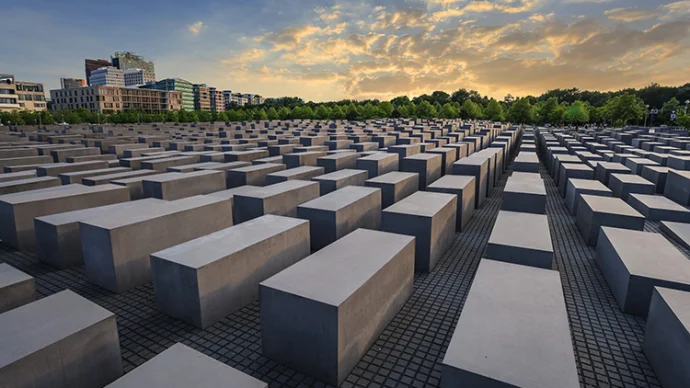
About The Holocaust Memorial – Berlin
The Holocaust Memorial in Berlin, also known as the Memorial to the Murdered Jews of Europe, is an installation commemorating the genocide of the Jewish people perpetrated under Adolf Hitler and the Nazis.
A place of contemplation, remembrance and warning, close to the Brandenburg Gate in the heart of Berlin, this site is a monument to the six million European Jews who died in the Holocaust.
The Holocaust Memorial Berlin history
After lengthy debates, in 1999, the German parliament decided to establish a central memorial site, the Memorial to the Murdered Jews of Europe.
A competition was held to design the memorial which was won by New York architect Peter Eisenman. The memorial was ceremonially opened in 2005 in Mitte on a stretch of the former “death strip” where the Wall once stood near Brandenburg Gate.
The area is open day and night and from all four sides you can fully immerse yourself in the fully accessible spatial structure. The memorial comprises of 2711 concrete slabs of different heights that stand on a site covering 19,000 square metres.
The slabs are arranged on a slight slope and the configuration’s wave-like form is different wherever you stand.
The structure’s openness and abstractness give onlookers space to confront the topic in their own personal way. The sheer size of the installation and its lack of a central point of remembrance call into question the conventional concept of a memorial. This creates a place of remembrance, but not with the usual means.
The memorial to the Shoah is supplemented by the underground information centre, also designed by Eisenman. In a space covering 800 square metres you can find information on the victims and the locations. Themed rooms such as the Room of Dimensions, the Room of Families, the Room of Names and the Room of Sites deal with the fates of individuals, with photographs, diaries and farewell letters. Short biographies take the victims out of their anonymity. Historical photographs and film footage show the sites of persecution and extermination.
The Holocaust Memorial Berlin today
Many people felt that the Memorial to the Murdered Jews of Europe should include inscriptions, artifacts, and historical information. This was achieved with the underground information centre that was not part of Eisenman’s original vision for the memorial yet is now a significant part of the visitor experience of the site.
The last entrance to the memorial 45 mins before closing each day and it is not suitable for under 14s.
Getting to the Holocaust Memorial Berlin
Visitors can reach the memorial by S-Bahn train, Underground or Bus.
Featured In

Holocaust Sites
Explore the harrowing events and effects of the Holocaust through these important sites, museums and memorials around the world.

Holocaust Sites in Germany
Uncover the devastating history of the Holocaust at these historic and significant locations around Germany.

World War Two Sites Around The World
Important, and often harrowing, reminders of World War Two can be found in sites, museums and memorials across the globe. Here are 10 of the most significant.

10 Historic Places to See in Berlin
Dating to the 13th century, Germany's vibrant capital Berlin is brimming with history. Here's 10 sites that you can't miss.




















